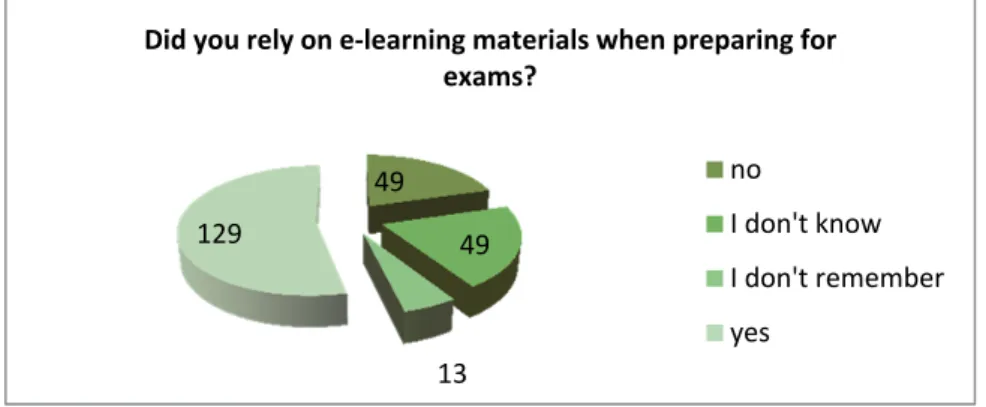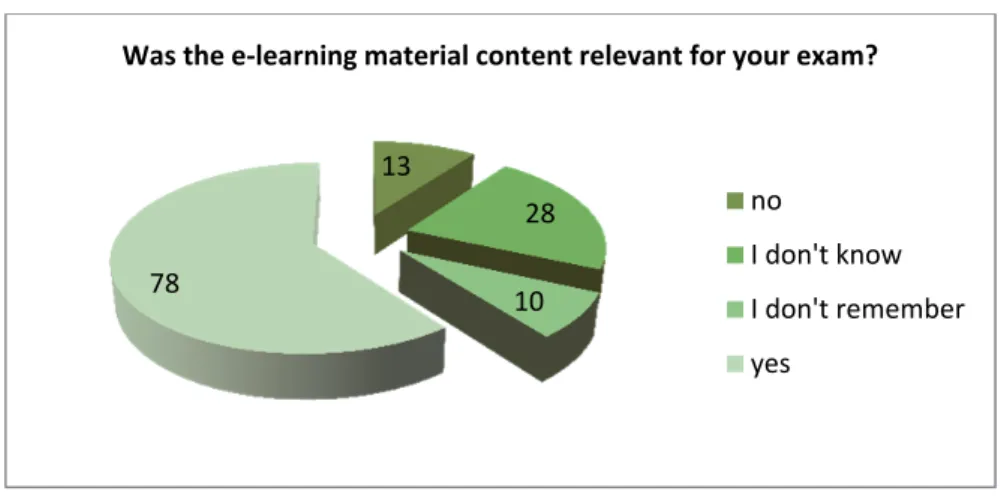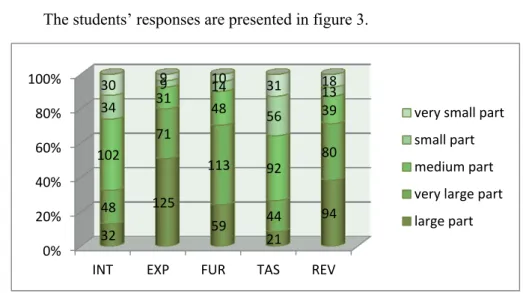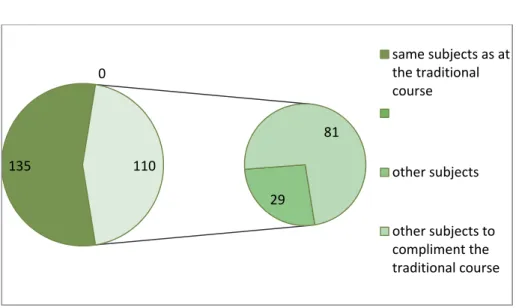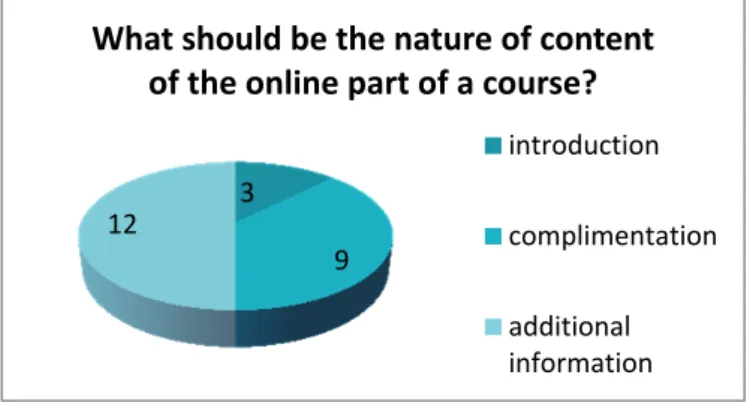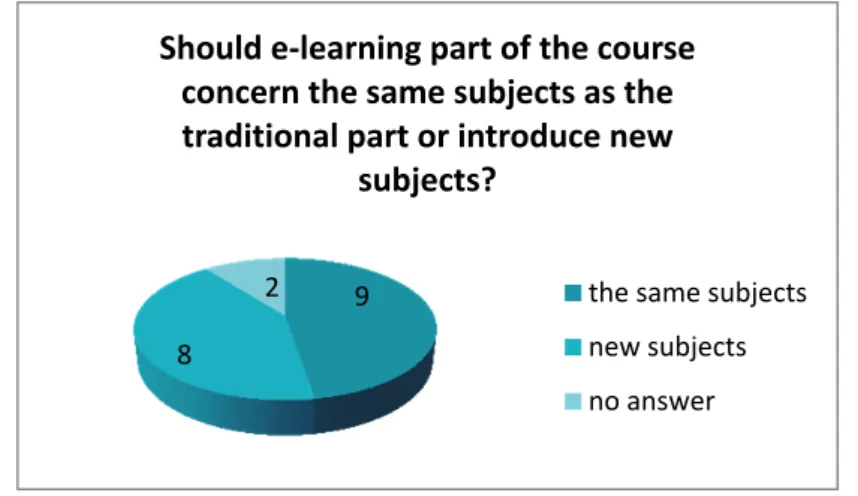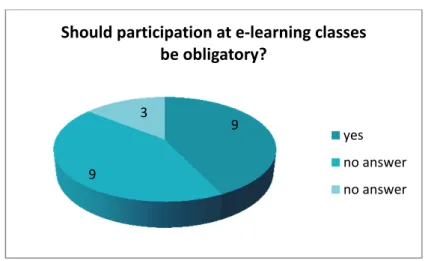Distance Teaching as an Element of an Academic
Course.
Original Research Results
Małgorzata Madej, Ph.D.
Wyższa Szkoła Handlowa we Wrocławiu, Poland malgorzata_madej@gazeta.pl
Agnieszka Faron, Ph.D.
Wyższa Szkoła Handlowa we Wrocławiu, Poland agnieszka.faron@handlowa.eu
Magdalena Jakubowicz, M.A.
magdalena@jakubowicz.com.plWojciech Maciejewski, Ph.D.
Wyższa Szkoła Handlowa we Wrocławiu, Polandwojciech.maciejewski@handlowa.eu
ABSTRACT. E-learning and blended learning have gained growing interest and have become increasingly popular at schools, colleges and universities. However, neither institutions nor lecturers are entirely prepared to apply this new method. The paper presents results of an original research concerning blended learning at a private-owned college in Wrocław, Poland, Wyższa Szkoła Handlowa (WSH). The research relied on online questionnaires and interviews and it was designed to identify good and bad practices in order to improve quality and efficiency of teaching via an e-learning platform. The results discussed herein concern division of a course within blended learning – a compromise between traditional education and e-learning curricula. The article shows opinions of students and lecturers on which parts of particular subjects should be presented online or traditionally. It also refers these opinions to the published literature and to Polish legal provisions. The paper includes conclusions and recommendations for teachers and teaching institutions.
Key words: e-learning, blended learning, college curriculum, course planning, distance teaching
INTRODUCTION
Distance learning has evolved a great way from the 19th-century
correspondence courses to interactive online curricula in the 21st century.
E-learning and blended E-learning have gained growing interest and have become increasingly popular at schools, colleges and universities. It is an innovation supposed to make education more efficient, cost-effective and attractive. Especially in Poland this tool has only become a significant component of the education system (although its share in curricula is still quite small).
There are several processes in the modern information society that make distance learning an important component of education systems.
constant development of knowledge and technology: it forces professionals to keep expanding their knowledge, too, even upon graduating from formal curricula; this involves frequently necessity to study at specialist courses organised only by few universities and therefore physical attendance at the course may pose a difficulty;
lifelong learning: as it is more and more natural or even required for adults, who are not students any more, to continue their education, a growing number of people needs to reconcile studies with employment and family life; online lectures, classes and seminars are a chance to save time and expenses on traveling to the university site;
digital reality: more and more information is shared and diffused via internet; participation in the digital access to information and information processing through news services etc., as well as to online social life through social media etc. has become one of the spheres where exclusion is a threat, so it is important to shape ICT skills in all employees;
social inclusion: as European countries and their organisations promote social inclusion or even make it one of their crucial objectives (in the “Europe 2020” strategy (Europe 2020)), distance learning becomes also an important mechanism to make education easier and more accessible for disabled persons, inhabitants of peripheral and/or rural areas, people living in large families etc.
Electronic support of teaching is not only a way to adapt to the new reality, but it is also a natural development for education systems in the developing society and economy. “The time saved and also the efficiency of
using technology for educational purposes recommends it as the newest trend in the knowledge based economy and society” (Gudănescu Nicolau, Popescu, 2013). Therefore, e-learning has to be introduced to a growing extent in graduate and post-graduate curricula, it can be also useful at earlier stages of education. And broader implementation of this mechanism requires development of methods to be used in e-learning. However, neither institutions nor lecturers are entirely prepared to apply this new method.
Obviously, there is still a need for further research of e-learning in the broad social and technological context (Li, 2013), but it is also important to look at the actual use of e-learning by individuals who want to learn and by professionals. The present paper has an applied character and explores practical implementation of e-learning in the formal academic training. It is based on results of original research concerning blended learning at a private-owned college in Wrocław, Poland. The research relied on online questionnaires and interviews and it was designed to identify good and bad practices in order to improve quality and efficiency of teaching via an e-learning platform.
The results discussed herein concern division of a course within blended learning – a compromise between traditional education and e-learning curricula. The article shows opinions of students and lecturers on which parts of particular subjects should be presented online or traditionally. It also refers this opinions to the published literature and to Polish legal provisions.
Literature and terminology review
Distance learning has evolved from correspondence courses to one-way transmissions and two-way TV camera systems (Cristensen, Anakwe, Kessler, 2001) to completely interactional synchronous e-learning nowadays. As a large majority of distance education (defined as learner and teacher’s separation in space) is now carried out by electronic means, making it e-learning (Bolliger, Wasilik, 2009), we sometimes apply the term “distance learning” in this narrower meaning. The crucial term of our paper is “blended learning”. A course is considered entirely e-learning, if 80% of its content is provided by online means (Simonson, Smaldino, Albright, Zvacek, 2009), and other courses with more balanced distribution of online and classroom content transmission are referred to as “blended learning”, i.e. a mix of different methods.
E-learning is basically categorised as synchronous (no time separation of learner and teacher) and asynchronous (where learners analyse the provided content at any time, without specific direct contact with the
teacher). However, the methods can be also divided into teacher-centred or learner-centred, passive or active, more or less interactive ones (Mohr, Holtbrugge, Berg, 2012).
Since mid-1990s distance learning has become an important factor of universities’ and colleges’ curricula (Bolliger, Wasilik, 2009), and in the three decades of its application there have been a lot of research on the method. They involved basically such issues as comparison of learning effects achieved via traditional and non-traditional classes (Pai, 2012; Mintu-Wimsatt, 2001) and the impact of the technological revolution on universities and colleges themselves (Huynh, Umesh, Valacich, 2003). Quality management issues were studied (Ossiannilsson, Landgren, 2012), too, for instance in the context of leadership and management styles (Holt, Palmer, Gosper, Sankey, Allan, 2014). Thus, researchers tended to focus on how e-learning affects or doesn’t affect student outcomes and user satisfaction. Introduction of this new method triggered independent and comparative analysis of how staff and students perceive e-learning (Bolliger, Wasilik, 2009; Beyth-Marom, Saporta, Caspi, 2005).
Even though as early as in 1999, Merisotis and Phipps in their analysis of then available published results emphasized the lack of overall assessment of the role of e-learning in academic curricula (Merisotis, Phipps, 199), this gap hasn’t been compensated for yet. There is a broad agreement that blended learning, curricula or courses which comprise both in-class and non-traditional components, may in fact enrich the process of education (Hiltz, Turoff, 2005), so as to reduce the diagnosed weaknesses of e-learning and take the best of its diagnosed strengths (Nelson, 2001). We wanted to pursue this question, by reflecting on how to blend different elements in order to provide the most benefits of all methods to students.
Introduction of e-learning in higher education in Poland
E-learning is quite a novel method and its implementation in Poland has just started. The first conclusion of a large EU-funded research project concerning diagnosis of the situation of e-learning in Poland and selected countries of the European Union and diagnosis of educational needs of teachers and students in distance education provided that “The share of e-learning in vocational education and lifelong e-learning in Poland is marginal” (“Diagnoza…”, 2013). Despite its known advantages and solutions to cope with its shortcomings, this method of teaching has not been broadly applied or popular in Poland. It is actually hardly known to teachers and students (“Diagnoza…”, 2013).
The situation is different with higher education institutions, both private-owned colleges and public universities. There, more and more frequently, e-learning platforms are introduced to make curricula more attractive and accessible to broader target groups. This was even easier between 2007 and 2013, when the EU-funded “Human Capital” Operational Programme provided finance for innovative education.
However, short time of practice of application of e-learning in Poland is reflected in too little reflection on methods of distance teaching. There are not enough teachers qualified to teach by e-learning, and as they tend to use traditional methods, the distance teaching system in Poland is often inefficient (“Diagnoza…”, 2013, p. 218). The quality of application of e-learning is determined by teachers and lecturers’ skills of application of modern technologies, their knowledge and understanding of the particular platform, but also by their ability to adapt their courses and lectures to this new method of teaching (Puchalski, 2011, p. 44).
MATERIAL AND METHOD
The paper presents a part of the results of an original empirical research held by the authors in fall 2013 and winter 2014. The research concerned e-learning introduced at a private-owned college in Wrocław, Wyższa Szkoła Handlowa (WSH). The e-learning scheme was made a component of the college’s B.A. and M.A. curricula in the academic year of 2011/2012, so the study involved a short-term evaluation after two years (four semesters). Purchase of the e-learning platform was funded by the European Social Fund and public contribution within the “Human Capital” Operational Programme.
The college resolved to start by introducing e-learning in the form of blended learning which provides for dividing particular subjects so that they are lectured partially at traditional classes and partially online (Przybyła, Ratalewska, 2012, p.9). Thus, the lecturers and students had an opportunity to get used to this form of education.
The main research objective involved identification of good and bad practices in implementation of distance teaching and methods applied to hold online classes. The intention was to use this data to develop a set of recommendations concerning organisation and teaching at e-learning platforms to make this method more efficient and convenient for students and lecturers.
The study was held by four researchers, all of whom had held e-learning courses. There were four basic sources of data:
a. online questionnaire for students: all students of WSH were provided with the link and asked to fill it in; they have submitted almost 250 filled in questionnaires: the sample was not representative, but it included students of various cycles (B.A. and M.A.) as well as different fields of studies; b. interviews with lecturers who had classes at the e-learning
platform at WSH; the interviews were based on questions analogical to those asked to students so as to ensure comparability of the data provided by those two sample groups; 19 interviews were held with lecturers of different specialisations, degrees and ages;
c. personal experience of the researchers; d. analysis of the available literature.
The study included also questions concerning the respondents’ general attitudes to e-learning and their overall assessment of this method of teaching. This paper presents the respondents’ opinions concerning blended learning and the necessary division of material to be taught between the traditional and e-learning part of the course.
Online questionnaire for students Data collection tools
The questionnaire included 29 questions arranged in five parts: content and form of materials provided, technical issues, methods of teaching, respondent data and overall attitude to e-learning. This division and inclusion of variable questions had two main purposes: to approach different issues related to e-learning and to analyse various aspects of the teaching process. Most questions were provided with suggested answers and a space for comment.
The data obtained from the student questionnaire were then compared with information provided by lecturers. The researchers interviewed 20% of all lecturers who had held any e-learning classes at WSH, focusing on persons who conducted more such lectures and on persons who had similar experience from other universities, colleges or training.
The interviews were based on a questionnaire similar to the one provided to students. It was adapted by replacing questions concerning assessment of different content and methods with questions on the lecturers’ personal experience with application of particular teaching styles or material types. The structured interviews were documented by lecturers’ real-time
notes. Thanks to the structured nature of the interviews, it was possible to perform comparative analysis of their opinions. However, the analysis of their statements and assessments was mainly qualitative. Quantitative analysis was possible, for most questions, as in the case of the students’ questionnaire were provided with answers to be selected, but the most valuable part of the interviews involved the lecturers’ free comments related to particular answers.
Study group
The questionnaire was made available online and delivered to students via their college mailboxes. The researchers also asked students in person, at traditional lectures to fill the questionnaires. All student groups at WSH were addressed by both methods (e-mail and requests at traditional lectures) and asked to take part in the study. Thus, the questionnaire was delivered to the entire studied population of students of the selected college. This was possible because – according to the college’s policies – all students had an opportunity to participate at traditional and e-learning classes and thus they all had means to compare their e-learning experience with in-classroom learning.
There were four fields of studies offered at WSH at that time at two levels, thus combining into six major groups of students (first-cycle Tourism and Recreation, second-cycle Tourism and Recreation, first-cycle Management, second-cycle Management, first-cycle Internal Security and second-cycle European Studies). At the fall semester of 2013/2014, when the study was conducted, there were approximately 1.200 students enrolled at WSH. Out of them, 241 students answered the questions, including:
24 students of first-cycle Tourism and Recreation 44 students of second-cycle Tourism and Recreation 55 students of first-cycle Management
52 students of second-cycle Management 60 students of first-cycle Internal Security
7 students of second-cycle European Studies (this was the smallest group within the entire population, too).
Therefore, almost 21% of the entire population responded to the request and submitted their answers and all major groups were represented.
Almost 85% of the respondents were part-time students, which reflected the proportion of WSH students at the time. Over 60% of the respondents were female, which also corresponded to the actual proportion in the population, as WSH offers studies in social sciences, which are more popular with women in Poland. There were also representatives of various age groups, especially the youngest ones (18% aged below 20; 16% aged 21-22
and 25% aged 23-24), but also a little elder group (30% aged 25-35 and 9% aged 35-45) and even the eldest group (2% aged above 45). The sample was not large enough to enable comparisons between age groups, but it visibly contained all groups who studied at WSH. It needs to be stressed that people above the traditional student age of 20-25 are an important consumer of higher education in post-communist Poland.
The lecturers’ group included 19 randomly selected academic teachers, with 52.3% of women and 47.7% of men. The group included lecturers of all degrees represented at the university (professors, PhDs, MAs). There were junior and senior lecturers among them, their age ranged from 30 to over 60 years. Almost two thirds were aged 40-59, but there were also representations of younger instructors and elderly lecturers (above 60). They specialised in variable subjects (management, marketing, political sciences, foreign languages, tourism, forensics, economics, sociology, law), which corresponded to the variability of courses offered at the college. 30% of the respondents were management lecturers, 30% specialists in social sciences.
Validity and reliability
It has to be stressed that the sample was not representative: those students submitted questionnaires who were willing to cooperate and interested in assistance at research. As a result, these may have been more active people and the findings may be biased by their attitude. However, the sociometric characteristics of the study group were similar to the overall population.
In the case of lecturers, the selection was random, but the group was variable enough to cover different attitudes. Considering the small group, the lecturers’ declarations should not be projected on larger groups without further research. This is why this part of findings is treated as a supplementation to the students’ answers.
Data analysis
All the data provided by respondent students were included in a single overall spreadsheet and then they were manually processed by researchers. The quantitative analysis relied on differences in selecting various possibilities and comparison of answers between students and lecturers’ respondent groups. The data obtained were analysed statistically to compare answers concerning particular issues, divided into the five sections (content and form of materials provided, technical issues, methods of teaching, respondent data and overall attitude to e-learning). Parallel construction of questionnaires for the two study groups enabled comparisons between them. At the same time, the study among lecturers was carried out by interviews
and not by questionnaires, and therefore the teachers’ overall remarks could be applied for an in-depth qualitative analysis.
The present paper discusses a selected group of interrelated questions. The following presentation of findings reflects the division included in the questionnaire and discusses the two different elements: content of an online course and forms of implementation of this system. Separately, we present corresponding answers provided by lecturers, so as to enable comparison. The figures present the respondents’ answers to selected questions. This part of the paper is also enriched by direct quotations of the respondents’ remarks to present different attitudes. We focused specifically on those lecturers within the study sample who expressed particular interest or experience in e-learning. The results obtained were confronted with other researchers’ findings.
The findings of all types of analysis – quantitative analysis of students’ and lecturers’ responses, qualitative analysis of lecturers’ comments, as well as review of the available literature – were the basis for our conclusions concerning two areas of implementation of elearning: firstly, the issue of student motivation in the process, and secondly construction of a blended learning course.
FINDINGS
Role of e-learning within curricula as seen by students’
As the objective of the teaching process – distance teaching or any other form – is to provide the students or recipients with certain knowledge, skills or competencies to be assessed at exams and then applied in practice, an important measure of efficiency of teaching involves how the knowledge is used for knowledge verification. This reflects also the adaptation of the course content and assessment methods.
Figure 1. Application of e-learning materials in preparation for exams – students’ declarations (n = 241) Source: original analysis of research data.
49 49
13 129
Did you rely on e-learning materials when preparing for exams?
no
I don't know I don't remember yes
As shown in Fig. 1, more than a half of the respondents among students declared that they had relied on e-learning materials provided by lecturers in preparation for final assessments and only one in five of them failed to do so. It suggests that they had found the materials relevant for the content of the course.
We have also attempted to check whether the materials actually corresponded to the knowledge/skills required at the final examination. In this case, over 60% of students who used the materials in preparation for the exams, were satisfied with the materials provided by lecturers.
Figure 2. Relevance of e-learning materials in preparation for exams – students’ declarations (n = 129) Source: original analysis of research data.
Only 10% of respondents declared that the provided material was not relevant, while an interesting 30% of them was unable to answer this question unequivocally.
These findings seem to suggest that basing on their previous knowledge, education and experience, lecturers were able to produce online materials and classes which made a relevant part of their courses. We found it valuable to check, which part of the course this was, considering the following:
theoretical introduction (INT) practical examples (EXP) further explanations (FUR) tasks to do independently (TAS) revision materials (REV)
13
28 10 78
Was the e-learning material content relevant for your exam?
no
I don't know I don't remember yes
The students’ responses are presented in figure 3.
Figure 3. Responses to the question: “How much of the e-learning should be devoted to particular type of material?” (n = 241)
Source: original analysis of research data.
This shows that students actually expect e-learning courses to include all parts of a course in general. Strikingly, more than 80% of the respondents require practical examples to cover a very large or large part of the online materials, which probably reflects their overall attitude to education and their overall expectations that studies curriculum should constitute a process of practical preparation for their professional life. Elsewhere, more than 70% of the respondents wanted a large or very large part of the e-learning course devoted to additional explanations supplementing the traditional classes, while less than one third of them had similar opinion on theoretical introduction. This proportion suggests that so far, students are not used to treating e-learning as a regular part of the course and they are more willing to see it as an extra source of information for those who are especially interested in the subject. This attitude is confirmed by the overwhelming majority favouring facultative instead of obligatory character of e-learning (more than 91%). It is probably related also to students’ unwillingness to study from home as extra hours apart from traditional lectures. This unwillingness is largely motivated by the difficulty to reconcile such additional duties with regular professional and family lives.
Also, a majority of students declared that e-learning classes should be devoted to further discussion of subject presented at traditional classes instead of new subjects (Fig. 4). Even among those who were in favour of discussing different subjects, almost 75% declared that these should be subjects “to compliment the traditional course”.
0% 20% 40% 60% 80% 100%
INT EXP FUR TAS REV
32 125 59 21 94 48 71 113 44 80 102 31 48 92 39 34 9 14 56 13 30 9 10 31 18
very small part small part medium part very large part large part
Figure 4. Responses to the question: “Should the e-learning part of the course present the same or other subjects as compared to the traditional part?” (n = 241)
Source: original analysis of research data.
It seems at moments that students are worried that this type of classes would shift the college education too far to independent self-development. They don’t want the e-learning course to cover too many details and require too much time and effort on their part (once again, as an addition to their participation at traditional lectures and practical classes): “the content should not be very extensive. I have encountered very large materials at the platform and analysing them was hardly possible. (…) More attention should be paid to complimenting information and presenting several examples / explanations” (quoted from a questionnaire). This also reflects their objection to learning theory online. It is consistent with findings by N. Esgi that students preferred teacher-led e-learning classes to independent self-education (Esgi, 2012, p. 449).
Concluding, students seem somewhat confused about their expectations towards e-learning as a part of their regular curriculum and as a part of courses, held partially at traditional classes and partially via an e-learning platform. Being uncertain as to how to treat this form of teaching, they seem quite positive that they don’t want it to replace the traditional education, they rather expect it to supplement lectures or provide additional information on the subject discussed.
135 0 29 81 110 same subjects as at the traditional course other subjects other subjects to compliment the traditional course
Role of e-learning within curricula as seen by lecturers
The study involved also an analysis of opinions of the other party of the teaching process – lecturers. Importantly, all the respondents had held online lectures at WSH, so their views were based on their practical experience.
As far as inclusion of different elements of content in the e-learning part of a course, the lecturers stressed that basically any content may be included in the e-learning curriculum, from revision materials to the entire course. They perceived e-learning as a tool which might be used to convey all types of knowledge with slight preference in favour of practical examples and against theoretical introduction.
In their opinions concerning selection of material for the e-learning part of their courses, the lecturers stressed two obvious issues. Firstly, dependence of the content provided on the type and nature of the course: “Actually, any type is possible, depending on the subject and how it is lectured” (quoted from an interview). And secondly, dependence of the selection of material on organisation of the course and proportion of traditional and e-learning hours: “when there are more e-learning hours, the programme may be organised otherwise, you can proceed from an overview to details, for instance discussing one topic at three e-learning classes” (quoted from an interview).
When asked whether e-learning should focus on introduction, complementation or additional development of content of the course, the respondent lecturers were quite ambiguous about the two latter parts, but they were quite positive that introduction should be presented at traditional classes (Fig. 5). This correlates with the attitude of respondent students, and it confirms the uncertainty of both parties concerning application of this teaching method.
Figure 5. Responses to the question: “Which part of a programme should be taught at e-learning classes?” (respondents could select more than one answer).
Source: original analysis of research data.
3 9 12
What should be the nature of content
of the online part of a course?
introduction
complimentation
additional information
The lecturers were also asked whether the e-learning part of a course should present different aspects of subjects discussed at traditional classes or introduce new issues. Their opinions were divided almost half by half (Fig. 6).
Figure 6. Responses to the question concerning presentation of different aspects of the same subjects at e-learning and traditional classes (n = 19).
Source: original analysis of research data.
In some cases, this may be justified by the specific nature of the subjects taught, e.g. “economics contains no separate subjects, this is just a single, complex construct of knowledge” (quoted from an interview) vs. “law is a very large material to discuss, so any hour should be used” (quoted from an interview), but sometimes different answers were provided by persons of the same specialisation and reflected just their personal attitude.
The respondent lecturers were also divided as far as obligatory attendance was concerned (Fig. 7), but – as shown by their commentaries – this was related to their overall opinions on motivating students to participate at lectures.
9 8
2
Should e-learning part of the course
concern the same subjects as the
traditional part or introduce new
subjects?
the same subjects new subjects no answer
Figure 7. Responses to the question obligatory attendance at e-learning classes (n = 19). Source: original analysis of research data.
This data lead to a conclusion that lecturers still search for the most effective methods of e-teaching. In interviews, many of them admitted applying methods and rules proven at traditional classes. This shows that – despite regular training – the distance teaching methods evolve quite naturally and they would require some ordering and promotion of efficient practices.
DISCUSSION Motivation in e-learning
Motivation was one of the recurring subjects in interviews with lecturers. As e-learning is a new method in Poland, it is very important to persuade students that it is an equally important element of a course than any other. The importance of this subject was noted in the literature: “Teachers’ influence on students’ learning motivation is a well-researched topic. Nevertheless, the majority of such studies are situated in the conventional learning context despite the rapid growth of distance language learning” (Xiao, 2012, p. 365).
Students admit that without the face-to-face contact with the lecturer, they are less motivated and lecturers stress that e-learning offers lesser means to control students or their progress in learning.
It is well proven in the literature that “within the instruction process of higher education, the classroom context needs to create an atmosphere of motivational learning” (Abrahamson, 2011). The meaning of motivation –
9
9
3
Should participation at e-learning classes
be obligatory?
yes no answer no answer
both for students (Robinson, 2008) and lecturers (Schneckenberg, 2010) – has also been thoroughly analysed, proving that in such a setting e-learning-specific incentives should be developed and applied.
The respondents suggested the following methods of motivating students, verified in their practical experience (quotes from the interviews):
- “attendance should involve rewarding participation”;
- “students should be able to see clearly the liaison between material discussed online and the final exam”;
- “tests as a feedback for students and the lecturer, not as a method of assessment”;
- “inducing activity through different channels (visual, audio, kinaesthetic ones), […] time discipline (test accessible for exactly 20 minutes)”;
- “as much independence as possible, but respecting their possibilities, too”.
The diversification of methods applied to motivate students suggests that it is necessary to research this issue further and to share good and proven practices.
E-learning within the entire course curriculum
Application of e-learning in colleges and universities has been regulated by legal provisions issued by the Minister of Science and Higher Education (Regulation, 2007). The act provides that e-learning may compose no more than 60% of the entire curriculum. Interestingly, the lawmakers expressly provided that for any applied and practical exercises e-learning methods should play only an ancillary role. This contrasts with the opinions presented by the respondents who suggested avoiding theoretical and introductory subjects within e-learning courses.
In overall assessments of e-learning and its benefits students represent rather optimistic attitudes, although detailed opinions concerning different elements provided by universities and colleges via e-learning forms are very variable, e.g. students valued higher the administrational aspect of e-learning communication (provision of timetables, curricula etc.) than the material content (Raj, 2011). Therefore, in the case of blended learning – as applied at WSH – it is very important to design the correct proportions between traditional lectures, different kinds of practical classes and e-learning.
It should be stressed that our research confirmed the already documented high student satisfaction with blended learning as compared to purely traditional or purely distance courses (Martínez-Caro, F. Campuzano-Bolarín, 2011). Probably this preference of blended (or mixed, or
diversified) forms of teaching is due to its potential to satisfy variable motivation factors for different persons, as e-learning part is found more effective by some groups of students, while others are more satisfied with classroom lectures (Mohr, Holtbrugge, Berg, 2012).
Distribution of content and issues discussed was mentioned by respondent lecturers as a crucial element of e-learning curriculum planning and students’ responses confirmed its importance, too. Lecturers argued that it was better and more efficient to involve them in preparation of the virtual-traditional proportions, before they start planning the content of the course. Also, it is important that lecturers should have an opportunity to schedule sequence of particular classes, even if the university or college – as in the case of WSH – requires the initial and/or final class to be held in the traditional form. This goes in line with conclusions of Asanok et al., who rated “instructional structure” as one of the six components which determine the final shape of e-learning (Asanok, Kitrakhan, Brahmawong, 2008).
This shows that attitudes and opinions of the Polish students and faculty are similar to those represented elsewhere. Our study, like other research, confirmed the urgent need of good practice and experience sharing in this respect.
CONCLUSIONS
The analysed literature and interviews with lecturers show that methods of online teaching still require research and scientific reflection. Introduction of this method of teaching at colleges and universities is difficult, because neither students not lecturers are used and prepared to apply it, therefore it is a better solution to introduce it gradually, through an intermediary stage of blended teaching.
The case study discussed in this paper permits several conclusions and recommendations:
Division of the course within blended learning should be done very carefully and in consultation with lecturers who specialise in the area in question.
Before it becomes a more natural and welcome part of the curriculum – instead of an interesting innovation – e-learning should play a role of complimentary classes, while the fundamental material is still presented at traditional classes.
Lecturers should avoid offering pure theoretical knowledge by e-learning, as it is difficult to present it in an active and
activating form, e-learning classes should rather concern the most attractive part of the material, e.g. the practical applications of the issues discussed.
It is very important to treat e-learning as an integral, but separate part of the course by stressing the content designed for the part and by assessing (online or traditionally) knowledge or skills gained.
Lecturers should regularly share their experiences and improve their knowledge about the e-teaching methods and about good practices applied by their peers.
E-learning provides many interesting opportunities and also it allows for elimination of some barriers which occur in traditional education. But as any other innovation in education it needs to be introduced cautiously so as to attract the users and to get all the best possible out of this method.
Recommendations
The results allow for development of several practical recommendations:
- blended courses are a very good solution and are perceived so by students and lecturers, so it is valuable to introduce e-learning platforms through such courses.
- structure of a blended courses should be developed very meticulously, both concerning proportions of e-learning and traditional classes, as well as their sequence. This process should involve the university or college and the lecturers themselves, so as to find the perfect alignment of the course to the particular content. Only thus, can a course benefit from positive aspects of different types of university teaching and avoid their drawbacks.
- in planning their e-learning courses and classes, lecturers should keep in mind that in this setting, motivation mechanisms are a little different than in traditional classroom, but they are equally important for the learning outcome. They should focus on constant interaction with students, minding their feedback and adapting the course to make it as effective as possible.
- both colleges and lecturers themselves should provide systems for constant experience sharing in order to spread good practices.
- in Poland and other countries where e-learning is a new method, lawmakers should be more flexible and open for implementation in this method. The Polish provisions which restrict application of distance teaching in practical courses should be amended to allow responsible development of blended courses by institutions and faculty.
The overall recommendation from this study highlights the added value of blended learning systems as an innovation, possibility to develop digital skills among teachers and learners and another enrichment of the content transmission channels. Its application can be beneficial for colleges and students, if it is diligently planned and adequately organised. Involvement of all concerned parties is crucial for efficiency of blended learning.
REFERENCES
1. Abrahamson C.E., “Methodologies for Motivating Student Learning Through Personal Connections”, Forum on Public Policy, v2011 n3 2011.
2. Asanok M., Kitrakhan P., Brahmawong C., „Building a Critical Components for Successful Multimedia-based Collaborative e-learning Design Framework”, Fifth International Conference on e-learning for Knowledge-Based Society, December 11-12, 2008, Bangkok, Thailand
3. Beyth-Marom R., Saporta K., Caspi A., „Synchronous vs. Asynchronous Tutorials: Factors Affecting Students’ Prefences and Choices”, Journal of Research on Technology in Education, spring 2005, volume 37 number 3. 4. Bolliger D. U., Wasilik O., “Factors influencing faculty satisfaction with online
teaching and learning in higher education”, Distance Education Vol. 30, No. 1, May 2009.
5. Cristensen E. W., Anakwe U.P., Kessler E.H., „Receptivity to Distance Learning: The Effect of Technology, Reputation, Constraints, and Learning Preferences”, Journal of Research on Computing in Education, spring 2001, Volume 33, number 3.
6. “Diagnoza stanu kształcenia na odległosc w Polsce i wybranych krajach Unii Europejskiej oraz diagnoza potrzeb edukacyjnych nauczycieli i odbiorców w zakresie kształcenia na odległosć”, Warszawa 2013.
7. Esgi N., “Comparison of Effects of E-Learning Types Designed According to the Expository Teaching Method on Student Opinions”, International Journal of Academic Research Vol. 5. No. 5. September, 2013.
8. “EUROPE 2020. A strategy for smart, sustainable and inclusive growth”. 9. Gudănescu N. N., Popescu M.-L., “E-Learning Innovations in Higher
Education”, Romanian Review of Social Sciences (2013), No.4.
10. Hiltz S. R., Turoff M., “Education Goes Digital: The Evolution of Online Learning and the Revolution in Higher Education”, Communications of the ACM October 2005/Vol. 48, No. 10.
11. Holt D., Palmer S., Gosper M., Sankey M., Allan G., „Framing and enhancing distributed leadership in the quality management of online learning environments in higher education”, Distance Education, 2014, Vol. 35, No. 3. 12. Huynh M. Q., Umesh U. N., Valacich J. S., “E-learning as an emerging
entrepreneurial enterprise in universities and firms”, Communications of the Association for Information Systems (Volume 12, 2003) 48-68.
13. Li Z., “Natural, practical and social contexts of e-learning: a critical realist account for learning and technology”, Journal of Computer Assisted Learning (2013), 29.
14. Martínez-Caro E., Campuzano-Bolarín F., „Factors affecting students’ satisfaction in engineering disciplines: traditional vs. blended approaches”, European Journal of Engineering Education, Vol. 36, No. 5, October 2011. 15. Mintu-Wimsatt A., „Traditional vs. technology-mediated learning: a
comparison of students' course evaluations”, Marketing Education Review, Volume 11, Number 2 (Summer 2001).
16. Mohr A. T., Holtbrugge D., Berg N., “Learning style preferences and the perceived usefulness of e-learning”, Teaching in Higher Education, Vol. 17, No. 3, June 2012.
17. Nelson C. M., „Distance learning. A Beginner’s Perspective”, MANAGEMENT Accounting Quarterly, fall 2001.
18. Olearnik J. (ed.), „Nowoczesne kształcenie z wykorzystaniem technik multimedialnych – możliwości i przykłady”, Wrocław 2011.
19. Ossiannilsson E., Landgren L., “Quality in e-learning – a conceptual framework based on experiences from three international benchmarking projects”, Journal of Computer Assisted Learning (2012), 28.
20. Przybyła W., Ratalewska M., “Poradnik dla projektujących kursy e-learningowe”, Warszawa 2012.
21. Pai K., „Assessing Online vs Face to Face Learning”, Global Conference on Business and Finance Proceedings, Volume 8, Number 2, 2013.
22. Raj R., „Evaluating the innovation of Online Learning Systems in Higher Education”, International Journal of Management Cases, Dec2011, Vol. 13 Issue 4.
23. Robinson C.C., „New Benchmarks in Higher Education: Student Engagement in Online Learning”, Journal of Education for Business, November/December 2008.
24. Regulation of Minister of Science and Higher Education of the 2nd November, 2011 amending the Regulation concerning conditions to be fulfilled to allow holding classes at studies by distance learning methods and techniques, Journal of Laws of 2011, No. 246, item 1347.
25. Regulation of Minister of Science and Higher Education of the 25th September 2007 concerning conditions to be fulfilled to allow holding classes at studies by distance learning methods and techniques, Journal of Laws of 2007, No. 188, item 1347.
26. Schneckenberg D., „Overcoming barriers for e-learning in universities— portfolio models for eCompetence development of faculty”, British Journal of Educational Technology, Vol 41 No 6 2010.
27. Xiao J., “Tutors’ influence on distance language students’ learning motivation: voices from learners and tutors”, Distance Education Vol. 33, No. 3, November 2012.
